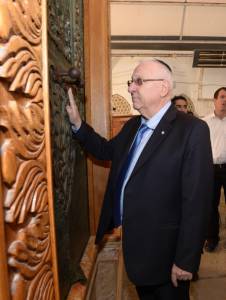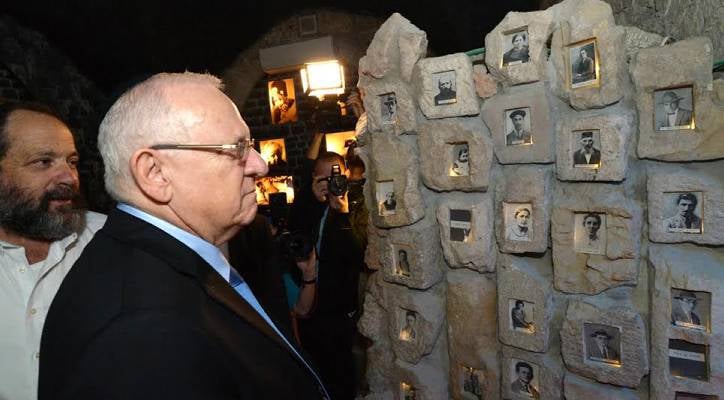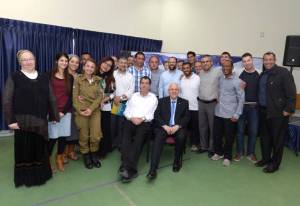On his first visit to Hebron as president, Reuven Rivlin emphasized that the city is “the place in which our rights to this land were originally established.”
By Anav Silverman/Tazpit News Agency
For the first time since elected to office, Israeli President Reuven Rivlin visited Hebron and Kiryat Arba on Monday. The Israeli president toured the Cave of the Patriarchs and also attended the inauguration ceremony for Hebron’s newly opened Jewish Heritage Museum in memory of the Jewish victims of the 1929 Hebron massacre.
Rivlin, who was sworn into office as Israel’s 10th president in July 2014, has a longstanding family connection to Hebron. His mother’s family, descendants of Chabad Hassidim, lived in Hebron. “This morning, I visited my family’s roots. There are those who fly to Krakow, or Casablanca, but for me, I have no need, not for a plane nor a passport, in order to visit my roots,” he said.

President Rivlin in Hebron. (Photo by Mark Neyman/GPO)
“I have come here today from the resting place of my late mother, Rachel Rivlin, on the Mount of Olives in Jerusalem, to the city of our forefathers, Hebron, where my mother’s family lived and worked.”
The President unveiled a plaque at the entrance to the Hebron Jewish Heritage Museum, saying that the museum told a story of 3,800 years. “For me this is not a cynical or political statement – it is a basic fact that is clear to me, and is also true in the wider national and public context, that the Jewish community in Hebron, tells the story of the creation of a nation, during its heyday, and also in difficult times.”
The Book of Genesis relates that Abraham purchased the field where the Cave of the Patriarchs is located to bury his wife Sarah. Later on, Isaac, Jacob, Rebecca, and Leah were all buried there. In Hebron, King David was anointed King of Israel and he ruled the city for seven years. There has been a continuous Jewish presence in the city throughout the Byzantine, Arab, Mameluke, and Ottoman periods until the Arab massacre in 1929, where 67 Jews were murdered. The Jewish community was reestablished after the Six Day War in 1967.
“Even those who differ in their views regarding the renewed Jewish settlement in Hebron cannot, and should not, deny the deep cultural and historic connection of the people of Israel to the city,” added President Rivlin, who frequently visited Hebron before he became president.
He also commented on the current situation of the city, the site of the oldest Jewish community in the world dating from Biblical times and one of Judaism’s four holiest cities. “Hebron is a difficult city, a city divided and pieced together. We do not need to pretend with you, who live here. The political reality has created difficult situations in Hebron, at times almost surreal, and yet it seems that life is stronger than anything else.”
Approximately 700 Jews and 250,000 Arabs live in Hebron today. Rivlin also visited Kiryat Arba, a city adjacent to Hebron that has absorbed immigrants from India and the USSR and whose population stands today at around 6,650 Jews.
“It is difficult to imagine the possibility of dialogue in Hebron. The memory of slaughter and blood; screams of the wounded and orphans, are part of a constant reminder that arise in the collective memory of the city. However, we can and should try. Such actions do not hurt or hinder our right to Hebron, a right that was bought during the days of the patriarchs, and stands strong to this day,” said the Israeli president during his visit.
“When the nation of Israel goes on a joint journey tracing its common roots, we find ourselves in Hebron, the place in which our rights to this land were originally established,” pointed out Rivlin.

